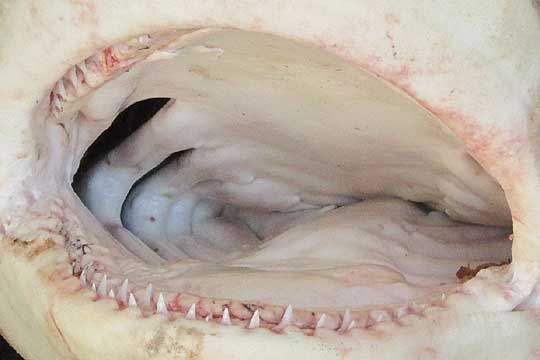Excerpts from Jim Conrad's
Naturalist Newsletter

from the February 1, 2015 Newsletter issued from Río Lagartos, on the Yucatan Peninsula's northern coast (~N21.60°, ~W88.16°), Yucatán state, MÉXICO
BULL SHARK
Wednesday morning Diego came to my door saying that a fisherman down the street had just brought in a 200kg (440lbs) Bull Shark. The big fish had been netted in deep water far offshore in the Gulf of Mexico north of Río Lagartos. Within a minute I had the picture shown above. That's my friend and student Paco astride the poor creature. Paco didn't catch the shark but he's our main crocodile wrestler on crocodile night tours and couldn't pass up posing with a shark.
A close-up of the shark's open jaws with its parallel rows of triangular teeth visible is shown below:

Diego had said that it was a Bull Shark, but I wasn't sure if that common name could be used to figure out the exact species in our photo. Fortunately, the Mexican government agency SEDUMA provides a freely available document in PDF format in which all the "elasmobranch" fishes off the Yucatan coast are listed -- an elasmobranch fish being a cartilaginous fish of the subclass Elasmobranchii, having five to seven pairs of lateral gill slits. The subclass includes the sharks, rays, and skates.
On the Internet, by comparing pictures of species of the shark genera listed in the document, simply by taking into account general shape and size, soon I felt confident that our shark was a member of the big genus Carcharhinus, of which a dozen species are listed for our coastal waters. Using pictures and data at the FishBase.Org website and noting our shark's large size, the size of its front fins (pectorals) relative to the rest of its body, its small eyes, its gray color and its short, broad snout, all the Carcharhinus names listed could be eliminated except this one: CARCHARHINUS LEUCAS. And the English name for Carcharhinus leucas was given as Bull Shark. All the other listed shark species were identified at FishBase.Org with different names, such as Silky Shark, Blacktip Shark, Whitetip Shark, Lemon Shark, etc.
FishBase.Org describes the Bull Shark as massive, with a short, broad and blunt snout, small eyes and triangular, saw-edged upper teeth. These features and the lack of an interdorsal ridge are sufficient, it says, to distinguish this species. Bull Sharks inhabit warm oceans worldwide, and have the distinction of being able to thrive in both saltwater and freshwater, sometimes traveling far up rivers. Though they are mainly a saltwater fish, they've been documented as far up the Mississippi River as Illinois.
Bull Sharks feed on bony fishes, other sharks, rays, mantis shrimps, crabs, squid, sea snails, sea urchins, mammalian carrion, sea turtles, and occasionally garbage. The FishBase.Org site describes them as probably the most dangerous species of tropical shark, repeatedly being implicated in attacks on humans. The IUCN Red List describes the species as being "near threatened."
I felt sorry for that Bull Shark, and wished that it had remained where it was, "far from shore and deep," as Diego had said.